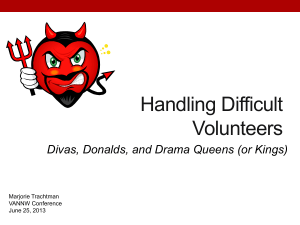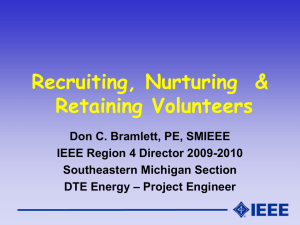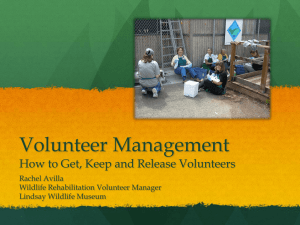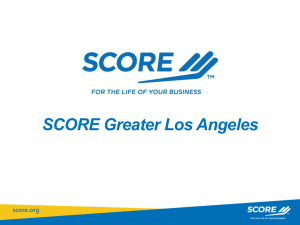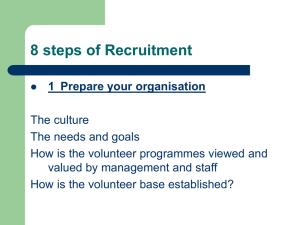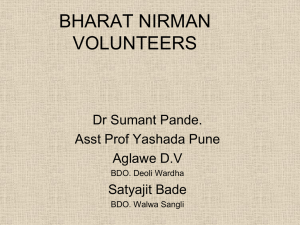PowerPoint: Volunteer Management
advertisement
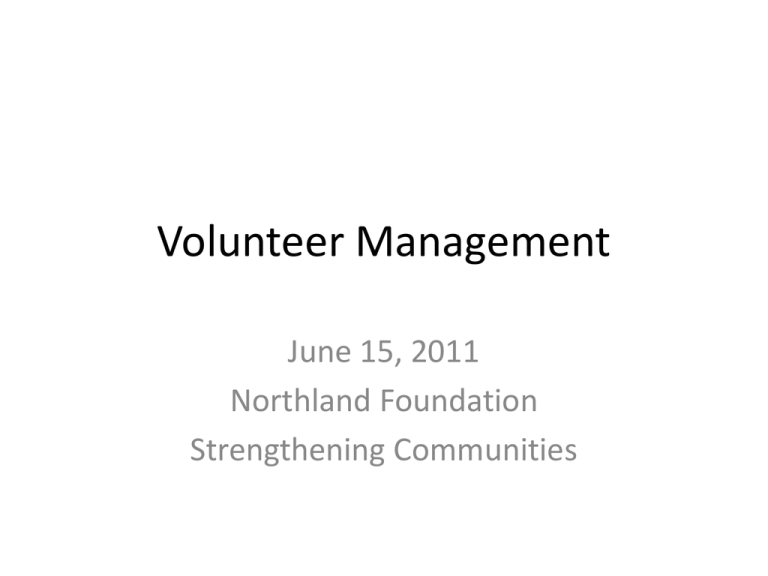
Volunteer Management June 15, 2011 Northland Foundation Strengthening Communities Agenda • • • • • • Welcome Overview and Expectations Complete Assessment Key Attributes Best Practices Volunteer Manual Why • • • • • • Personally asked Affiliation with the organization Personal connection to mission Enjoy type of work Want to learn new skills Want to meet people Motivate • Affiliation – Personal interaction, works to make friends • Achievement – Works toward goals, seeks responsibility, sticks to tasks until done • Power – Impact and influence others, work alone or group, responds to needs of people or programs Types of Volunteers • • • • • • Long term Short term – episodic Family Student Internships Virtual Volunteers • 40% stop due to poor management practices – Poor use of time – Not use skills or talent – Tasks not clearly define – People say often family or personal reasons 60% of nonprofits adopted nine volunteer management practices to some degree – Best practice most often used is supervision and communication Nine Practices • • • • • • • • • Supervision and communication with volunteers Liability coverage for volunteers Screening and matching volunteers to jobs Regular collection of information on volunteer involvement Written policies and job descriptions for volunteers Recognition activities Annual measurement of volunteer impact Training and professional development for volunteers Training for paid staff in working with volunteers What do we not do so well • Preparing for Volunteers – Inventory of tasks and skills – Screening and matching – Training of staff • Working with Volunteers – Orientation and Training – Measuring Impact – Recognition of Volunteers PREPARING FOR VOLUNTEERS We Think • • • • • Find someone to work with the volunteers Create job description (maybe written down) Recruit and assign volunteers (grab and go) Say thank you at end of shift Wonder why we do not retain volunteers Better Approach • Develop the philosophical base for why • Articulate the principles • Train the staff – engage and train Develop the Philosophy • Philosophical Base – Fundamental assumptions behind volunteering – Align with organizational priorities – Sets the direction for the volunteer program • Principles Of Volunteering – Core values about volunteering in organization Child Care Philosophical Base Mission Parenting Role Models Connections to Potential Donors Love and Nurturing Children in stable environment Caring for children Seeing and connecting to children Holding, caring, and love Achieving developmental milestones Modeling parental and grandparent behavior Impact on children – seeing the impact themselves Consistent people creates impact on child Supporting staff roles in teaching Learning by doing Giving back to the center Interaction among generations creates emotional bonds Demonstrating how to show love and nurturing behavior to children Seniors connecting to kids for senior health Learning environment with interaction with teacher each day Contribution to something that has value and impact Creating supportive environment for families in crisis Principles • We believe that children and families need a loving and supportive environment for their day care. • The interaction of seniors, children and their parents benefits everyone. • We respect the diversity of generations with each having their own attitudes and beliefs. • Loving care can be demonstrated to our parents. Training of Staff • Volunteers ineffective without the infrastructure appropriate – Key is support by paid staff so time not wasted – Forms – Orientation Basics • Formal training of staff – how to work with volunteers – – – – Purpose Goals Policies – Volunteers as Guests Expectations Preparing for the Volunteer • Screening and matching – Assessment and inventory of tasks, skills and expectations – BE CLEAR • Create job description • Be clear on skills • Create volunteer inventory form Position Description • • • • • • • • • Title Purpose/objective Location Key bulleted list of responsibilities Qualifications Time Commitment Training/Support Provided Benefits Supervisor and contact information Recruitment • Need a strategy – Personal Ask • • • • • Web site Social Media – facebook and twitter Centers Partnerships Networking WORKING WITH THE VOLUNTEER Making the Match • • • • • Application Interviewing (Inventory Done) Screening Matching the volunteer, the skill and the task Set the initial expectations Communication • • • • • • Be Prompt Be Clear Share Knowledge – impact Be personal Be reliable Think three emails and one phone call Communication • • • • • • Organizational Climate Organizational Structure Reward Warmth Conflict Identity Volunteer Training • Three type of Training – Orientation – Training (5 minute – 2 hour) • • • • Mission Goals Services Role – tasks to be completed – Ongoing Training - Development Orientation • • • • • • Reduce anxiety Limit Turnover Save Time for Program Staff Develops realistic expectations Sets positive attitudes Increase volunteer satisfaction Tips • Most important information first • Emphasize people as well as policies and procedures • Partner new ones with experienced ones • Age appropriate and sensitive to diversity • Promote exchange and questions • Okay not to know it all – get back to you or discussion Policies and Procedures • Short • Booklet • Long Manual • Policies tell people what to do • Procedures tell them how to do it Policies • • • • • Why you involve volunteers Role descriptions Recruitment and selection Relationship between volunteers and staff Relationship between volunteers and client group • Confidentiality, respect, diversity Policies…. • Training and development • Working conditions – Dress code – Name badges • • • • • Recognition Support and supervision Expenses Insurance Dealing with Problems Policies • • • • Written in present tense Clear, concise language External audience Approved by management - board Important Concepts • • • • Staff and volunteer have to work together Mutual beneficial relationship for both Skills and Task must match Make it a valuable experience – your image is at stake • Other – Welcoming Culture – Resources to Support – Volunteers to Recruit Other Volunteers Recognition • Recognition – Say thank you – Simple thank you gifts – during event – Appreciation events • Volunteer of the Day, Year, etc – Align with organization Newsletter Annual report Retention Musts • Retention Goal most impacted by: – recognizing volunteers – providing training and professional development – screening volunteers and matching them to organizational tasks Challenges Volunteer Perspective 1. Time 2. Responsiveness – Now 3. Technology 4. Generational Expectations 5. Dedicated staff resources Challenges • The Big Shift – Encore Volunteers – Skill based Volunteers • Funding – Resources for infrastructure and management of volunteers • National leadership and infrastructure PLANNING WORKSHEETS The Future Our choice as citizens • Pay more taxes • Go without the service • Volunteer Resources • Interest self assessment http://handsonmwv.org/docs/Interest_Self_Assessment_Exercise.pdf • Resource Web Site http://www.energizeinc.com/art.html Points of Light Foundation Hands on Network • Volunteer Management Best Practices http://blog.theregistrationsystem.com/wpcontent/uploads/2010/04/IFEA-Volunteer-Management-BestPractices.pdf

